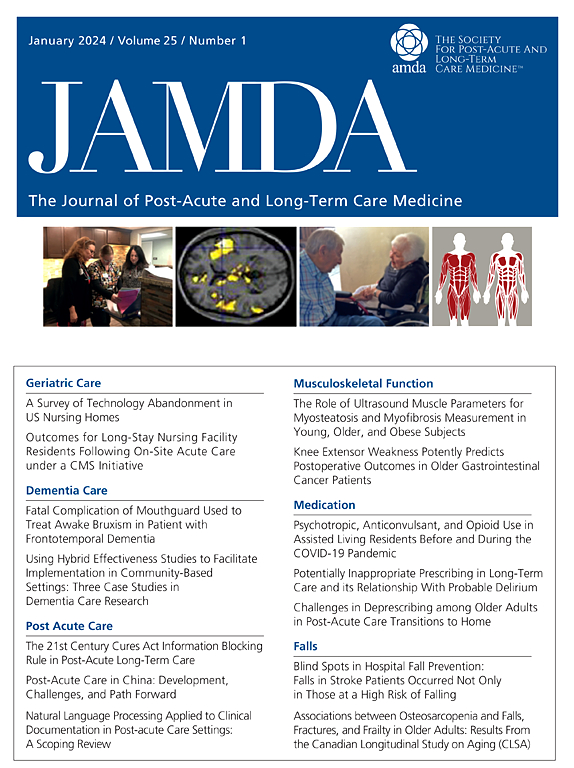Normative Data for Timed-Up-and-Go and One-Leg-Standing for 66-Year-Old Koreans: A Nationwide Study
IF 4.2
2区 医学
Q2 GERIATRICS & GERONTOLOGY
Journal of the American Medical Directors Association
Pub Date : 2025-07-24
DOI:10.1016/j.jamda.2025.105773
引用次数: 0
Abstract
Objectives
To investigate updated, sex-stratified normative data for timed-up-and-go and one-leg-standing tests among 66-year-old Koreans.
Design
Retrospective cross-sectional study using a large, nationally representative data set.
Setting and Participants
Data were obtained with official permission from the Korean National Health Insurance Service database. This study included 66-year-old citizens who participated in the National Screening Program for Transitional Ages between January 1, 2008, and December 31, 2017. Participants with missing values for the timed-up-and-go or one-leg-standing tests were excluded from the analysis. A total of 2,704,715 participants were included (53.7% female), with 2,231,397 analyzed for one-leg-standing.
Methods
The timed-up-and-go and one-leg-standing results were sex-stratified, and means, SDs, and the 5th, 10th, 25th, 50th, 75th, 90th, and 95th percentiles were calculated for each group. The influence of demographic, health behavior, clinical, and comorbidity variables on test performance was analyzed.
Results
Men outperformed women in both timed-up-and-go (men: 8.20 ± 3.33 seconds; women: 8.59 ± 3.30 seconds; P < .001) and one-leg-standing (men: 20.39 ± 9.19 seconds; women: 18.26 ± 8.72 seconds; P < .001). Both sexes showed improvements in the 2 tests over the 9-year period. Female sex, low income, obesity, and chronic conditions negatively impacted performance.
Conclusions and Implications
This study provides updated normative values for timed-up-and-go and one-leg-standing, facilitating more accurate mobility assessments and risk screening. Observed improvements in both tests among 66-year-olds over the time course of the study reflect positive public health trends in Korea. These findings emphasize the need for population-specific reference values and standardized protocols. Tailored health interventions are necessary for vulnerable populations. Updating cutoff values based on demographic trends may improve early intervention strategies, ultimately enhancing functional health and quality of life in older adults.
韩国66岁老人适时起身和单腿站立的规范性数据:一项全国性研究。
目的:在66岁的韩国人中调查最新的、按性别分层的定时起身和单腿站立测试的规范数据。设计:采用具有全国代表性的大型数据集进行回顾性横断面研究。环境和参与者:数据获得韩国国民健康保险服务数据库的官方许可。本研究纳入了2008年1月1日至2017年12月31日期间参加国家过渡年龄筛查计划的66岁公民。没有及时起身或单腿站立测试值的参与者被排除在分析之外。共有2,704,715名参与者(53.7%为女性),其中2,231,397名参与者被分析为单腿站立。方法:对每组的起跑时间和单腿站立结果进行性别分层,计算平均值、标准差和第5、第10、第25、第50、第75、第90、第95百分位。分析了人口统计学、健康行为、临床和共病变量对测试成绩的影响。结果:男性在起跑计时上均优于女性(男性:8.20±3.33秒;女子:8.59±3.30秒;P < 0.001)和单腿站立(男性:20.39±9.19秒;女子:18.26±8.72秒;P < 0.001)。在9年的时间里,两性在两次测试中都有所改善。女性、低收入、肥胖和慢性疾病都会对成绩产生负面影响。结论和意义:本研究为适时起身和单腿站立提供了最新的规范值,促进了更准确的活动能力评估和风险筛查。在这项研究的时间过程中,66岁的人在两项测试中观察到的改善反映了韩国积极的公共卫生趋势。这些发现强调需要针对特定人群的参考值和标准化方案。有必要对弱势群体采取有针对性的保健干预措施。根据人口趋势更新临界值可以改善早期干预策略,最终提高老年人的功能性健康和生活质量。
本文章由计算机程序翻译,如有差异,请以英文原文为准。
求助全文
约1分钟内获得全文
求助全文
来源期刊
CiteScore
11.10
自引率
6.60%
发文量
472
审稿时长
44 days
期刊介绍:
JAMDA, the official journal of AMDA - The Society for Post-Acute and Long-Term Care Medicine, is a leading peer-reviewed publication that offers practical information and research geared towards healthcare professionals in the post-acute and long-term care fields. It is also a valuable resource for policy-makers, organizational leaders, educators, and advocates.
The journal provides essential information for various healthcare professionals such as medical directors, attending physicians, nurses, consultant pharmacists, geriatric psychiatrists, nurse practitioners, physician assistants, physical and occupational therapists, social workers, and others involved in providing, overseeing, and promoting quality

 求助内容:
求助内容: 应助结果提醒方式:
应助结果提醒方式:


